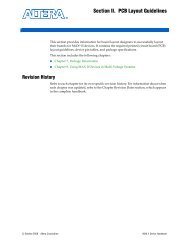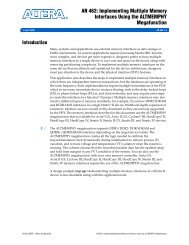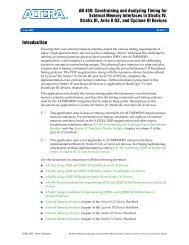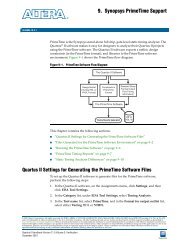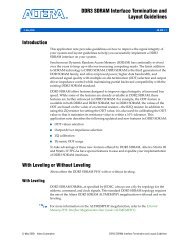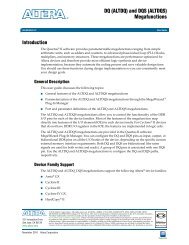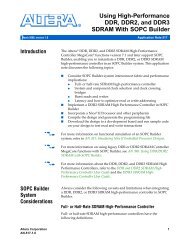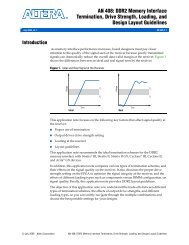MAX 9000 Programmable Logic Device Family Data Sheet
MAX 9000 Programmable Logic Device Family Data Sheet
MAX 9000 Programmable Logic Device Family Data Sheet
You also want an ePaper? Increase the reach of your titles
YUMPU automatically turns print PDFs into web optimized ePapers that Google loves.
<strong>MAX</strong> <strong>9000</strong> <strong>Programmable</strong> <strong>Logic</strong> <strong>Device</strong> <strong>Family</strong> <strong>Data</strong> <strong>Sheet</strong><br />
Timing Model<br />
f<br />
The continuous, high-performance FastTrack Interconnect ensures<br />
predictable performance and accurate simulation and timing analysis.<br />
This predictable performance contrasts with that of FPGAs, which use a<br />
segmented connection scheme and hence have unpredictable<br />
performance. Timing simulation and delay prediction are available with<br />
the <strong>MAX</strong>+PLUS II Simulator and Timing Analyzer, or with industrystandard<br />
EDA tools. The Simulator offers both pre-synthesis functional<br />
simulation to evaluate logic design accuracy and post-synthesis timing<br />
simulation with 0.1-ns resolution. The Timing Analyzer provides pointto-point<br />
timing delay information, setup and hold time prediction, and<br />
device-wide performance analysis.<br />
The <strong>MAX</strong> <strong>9000</strong> timing model in Figure 14 shows the delays that<br />
correspond to various paths and functions in the circuit. This model<br />
contains three distinct parts: the macrocell, IOC, and interconnect,<br />
including the row and column FastTrack Interconnect and LAB local array<br />
paths. Each parameter shown in Figure 14 is expressed as a worst-case<br />
value in the internal timing characteristics tables in this data sheet. Handcalculations<br />
that use the <strong>MAX</strong> <strong>9000</strong> timing model and these timing<br />
parameters can be used to estimate <strong>MAX</strong> <strong>9000</strong> device performance.<br />
For more information on calculating <strong>MAX</strong> <strong>9000</strong> timing delays, see<br />
Application Note 77 (Understanding <strong>MAX</strong> <strong>9000</strong> Timing).<br />
30 Altera Corporation




